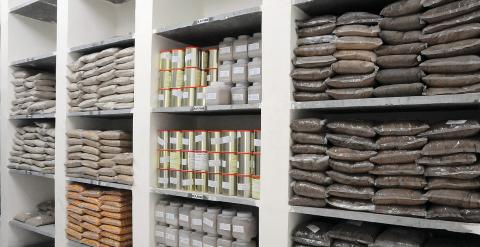1.1 Sampling
Since the samples forms the base for analysis, utmost attention should be taken in drawing out samples. It is generally found that the raw materials supplied are not of uniform quality. It is also common to note that some suppliers send the consignments with good quality materials in the periphery of gunny bag and inferior material in the centre. Hence, the sample should be drawn from the centre as well as from the periphery of the gunny bags. It is better to draw samples from all the bags (100 per cent sampling) as far as possible.
100 per cent sampling proves to be an efficient system for detecting adulteration during the receipt of material. Substandard material can be outright sorted and rejected. However, sometimes it may not be practical with a very large consignment. In such a case, a standard sampling procedure based on sound statistical techniques should be followed, where the quantity of each sample, number of samples and percentage of bags to be sampled is proportional to the size of consignment. In this way, the result would reflect the real picture of the entire consignment within the accepted range of accuracy. Sample collecting staff
should be adequately trained and sample should be collected strictly under the supervision of the animal nutrition officer. Every consignment should be given a separate code number so that it can be recorded for analysis, reporting and issuing. In India, Bureau of Indian Standards (BIS) has laid down the following procedures and precautions for collecting the samples for analysis:
1.1.1 General requirements of sampling
• In drawing, preparing, storing and handling samples, care should be taken that the properties of feeds are not affected.
• Take sample at a protected place not exposed to damp air, dust or soot.
• The sampling instrument shall be clean, dry and sterile when used.
• Protect the samples, the sampling instrument and containers for samples from adventitious contamination.
• Preserve samples in clean, dry and sterile containers. The sample containers shall be of such a size that they are almost completely filled by the sample.
• Each container shall be sealed air-tight with a stopper or a suitable closer after filling in such a way that it is not possible to open and reseal it without detection. Market full details of sampling i.e. the date of sampling, batch or code number, name of the manufacturer and other important particulars of the consignment.
• Sample shall be stored in sample storage room (Fig. 1.1) in such a manner that there is no deterioration of the material.
• Sampling shall be done by a person agreed to between the purchaser and the vendor and if desired by any of them, in the presence of the purchaser (or his representative) and the vendor (or his representative).
1.1.2 Scale of sampling
• The quantity of cattle feed of a particular type, produced under relatively similar conditions in a day shall constitute a lot.
• Samples shall be tested for each lot for ascertaining conformity of the material to the requirements of the standard.
• The number of bags to be selected from the lot shall depend on the size of the lot and shall be in accordance with table 1.1.

Fig. 1.1 Sample storage room
1.1.3 Preparation of individual samples
|
|||||||||||||||
Draw with an appropriate sampling instrument, equal quantities of the material from the top, bottom and sides of each bag selected. The total quantity of material drawn from each bag shall be not less than 1.5 kg. Mix all the portions of the material drawn from the same bag thoroughly. Take about 0.75 kg of the material and divide it into
three equal parts. Each portion, thus obtained, shall constitute the test sample representing that particular bag and shall be transferred immediately to clean and dry sample containers, sealed airtight and labelled. The individual samples thus obtained shall be formed into three sets in such a way that each set has a test sample representing each bag selected. One of the sets shall be for the purchaser, another for the vendor and the third for the referee.
1.1.4 Preparation of composite samples
From the mixed material from each selected bag remaining after the individual samples have been taken, equal quantities of the material from each bag shall be taken and mixed up together so as to form a composite sample weighing not less than 0.75 kg. This composite sample shall be divided into three equal parts and transferred to clean and dry containers, labelled and sealed airtight. One of these samples shall be for the purchaser, another for the vendor and the third for the referee.
1.1.5 Referee samples
Referee samples shall consist of a set of test samples and a composite sample and shall bear the seal of the purchaser and the vendor and shall be kept at a place agreed to between the two.
1.1.6 Testing of samples
Samples shall be tested for each lot for ascertaining the conformity of the material to the requirements of the standards.
1.1.7 Criteria for conformity
A lot shall be considered as conformity to the specification when the test results on the individual samples satisfy the requirement.
